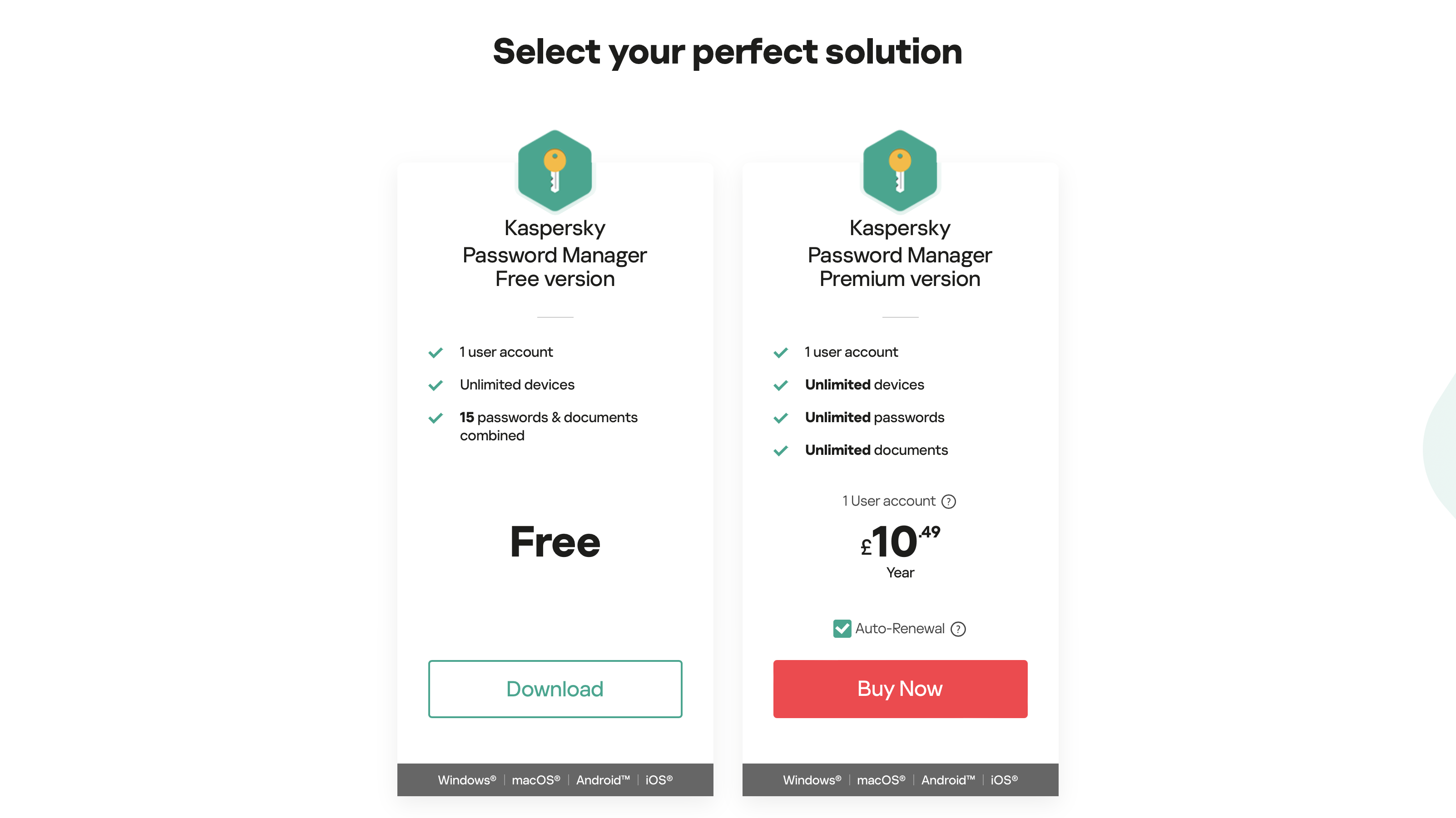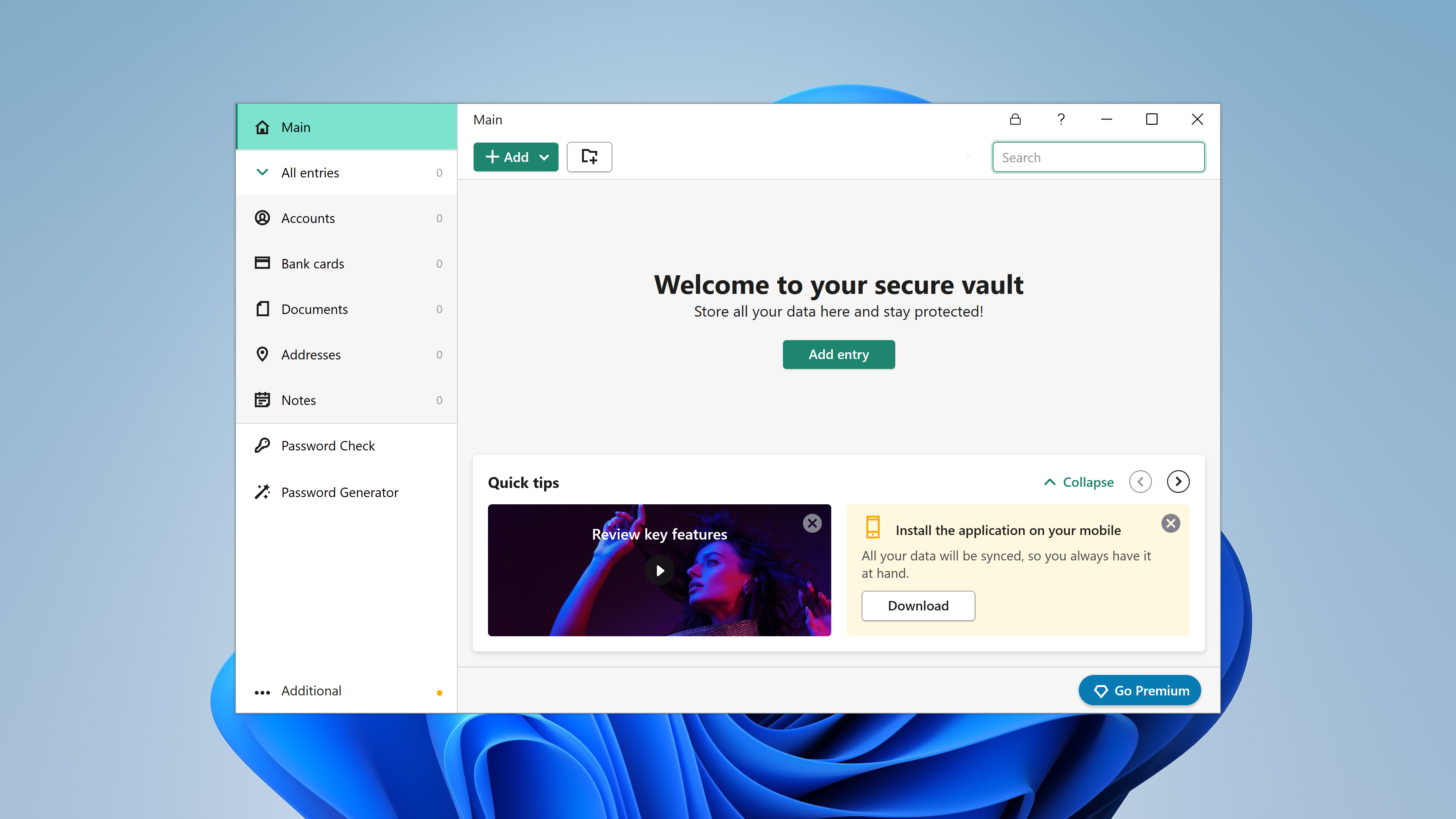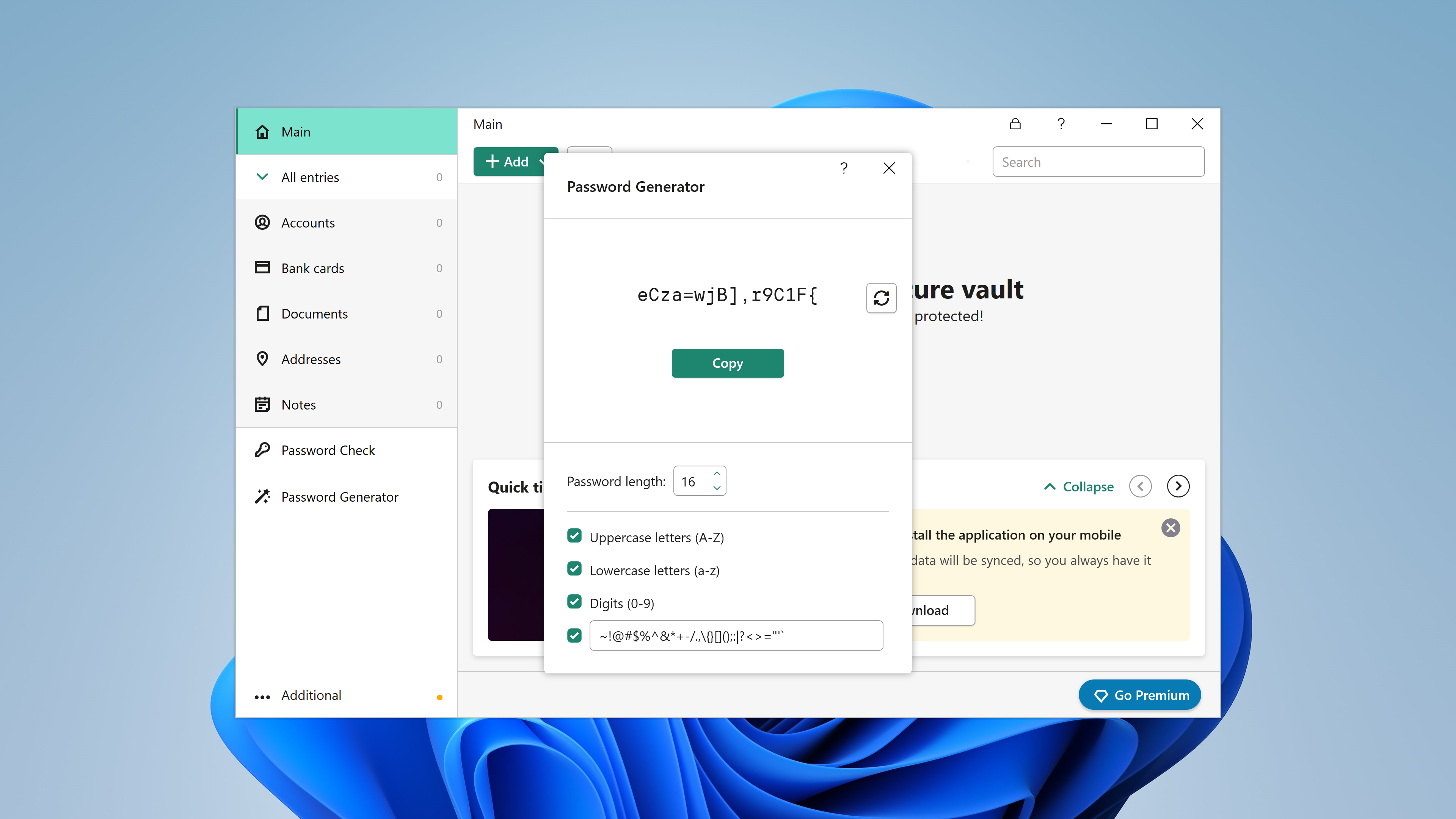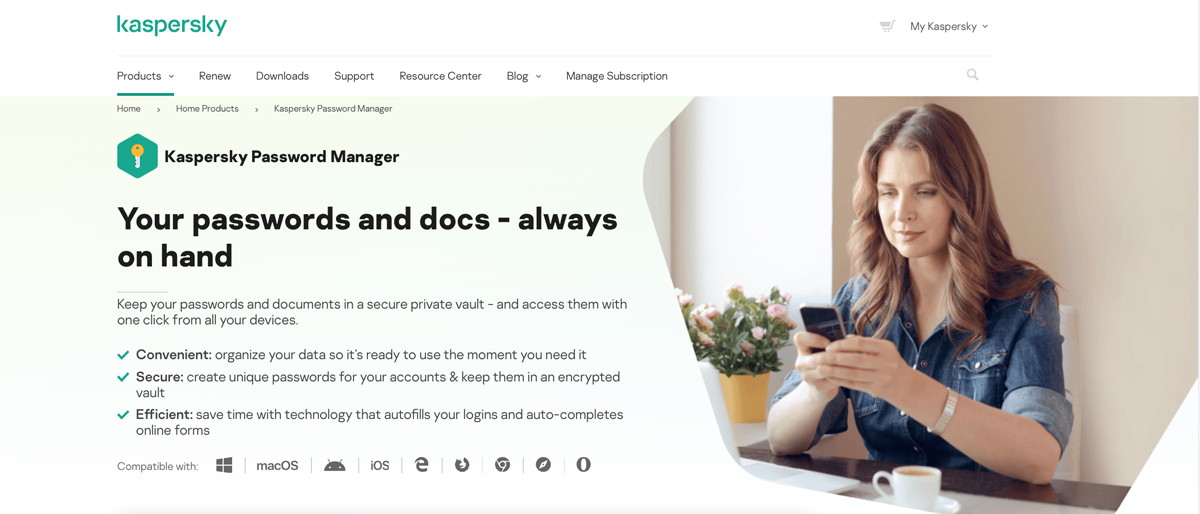TechRadar Verdict
Kaspersky Password Manager covers the basics well, including password auto-fill and cross-device syncing. But we found ourselves wishing for more flexibility and options for sharing passwords securely.
Pros
- +
Relatively affordable
- +
Good syncing
- +
Decent mainstream features
Cons
- -
Can’t customize data fields
- -
Sharing options are sparse
Why you can trust TechRadar
Kaspersky is one of the big names in security, so we’ve got high hopes for its password manager tool – and on paper the app impresses.
Kaspersky Password Manager includes every mainstream feature you would expect, from password vaults and auto-filling to a neat password generator. Furthermore, Kaspersky’s tool also aims to prove useful in other ways thanks to document and photo vaults, card and address logging, and biometric sign-in options.
The app misses some advanced features, so we’re going to find out if Kaspersky Password Manager can live up to its big-name status – or if lesser-known rivals are a more secure choice.

Kaspersky Password Manager: Plans and pricing
Kaspersky Password Manager has a free version that unlocks all features and works across devices. But, it’s limited to storing just 15 entries, which frankly isn’t enough for the vast majority of users, rendering the plan virtually useless.
The paid version costs $14.99 / £10.49 / AUD$18.99 per year and enables you to create an unlimited number of records. Although this is noted as the price for new customers only, there is currently no price increase after the first year, but we suspect this may eventually change given the careful choice of terminology.
You can also get access to the Password Manager as part of the two more expensive security plans in some markets, Plus (£18.99 per year) and Premium (£19.99 per year). It seems that this isn’t the case in the US or Australia, though.

Kaspersky Password Manager: Setup
Getting started with Kaspersky Password Manager is fast and easy. As with other password managers, you’ll start out by creating a master password for your account. If you want to use the software across multiple devices, you’ll also need to register and confirm an email account (you’ll need an account for a paid plan, anyway).
Sign up to the TechRadar Pro newsletter to get all the top news, opinion, features and guidance your business needs to succeed!
The first time you start the platform, it will prompt you to install a set of browser extensions to enable auto-filling. You can also download any stored credentials from your browsers to add them to your database. Helpfully, Kaspersky Password Manager supports importing entries from other popular password managers as well as CSV files.
Kaspersky Password Manager: Interface and performance
Kaspersky’s app interface will look familiar to anyone who has used another password manager, but there are some important differences. The first is that there are fewer data categories. Kaspersky Password Manager has six, whereas competitors like mSecure have more than 20. You’re able to create custom entries here, but you don’t get the templates, categories, or level of control that you’ll typically find elsewhere.
In addition, we didn’t love the way that Kaspersky Password Manager organizes information. You can create groups of entries, but there are no tags. The folder view is also a little bit harder to navigate than the simple list view that many other password managers use. Oftentimes, users value being able to clearly separate credentials for areas of their life, be it work and personal, or social media, banking, and so on.
The password generator in Kaspersky Password Manager is a standard affair. You can choose which special characters are allowed in a password, if any, but there’s no option to force it to create human-readable words. Some password managers do this, but it’s not especially common. Still, it would be nice to have more control.
Elsewhere, you get a conventional range of features. This app can store and autofill your payment details and addresses alongside login information, and synchronization across devices is near-instant. You can store documents in an encrypted vault, too. You also get leak detection and weak password checking.
That’s great, but Kaspersky Password Manager doesn’t have the high-end features found elsewhere, like self-destructing messages or powerful sharing options. You also can’t coordinate your passwords in alternative cloud storage services.
This app is available on Windows, macOS, Android, and iOS. It also has browser extensions for Chrome, Firefox, Edge, and Safari. That’s a solid slate of options for mainstream users, but this is another area where other tools go further – it’s pretty normal now to find support for more browsers and operating systems.
While Kaspersky has plenty of business products, its password manager is clearly designed to accommodate to basic consumer needs. With passkeys slowly gaining traction in consumer corners of the Internet, we would like to see support for these new passwordless login methods added. Kaspersky hasn’t expressed an interest yet, while many other competitors have either added or are on the verge of adding support. Given that the company is a heavy hitter in the world of cybersecurity, it’s a shame that it’s not paving the way here.
If you’re after a more rounded approach to cybersecurity, you’ll often find password managers bundling in VPNs to their more expensive plans. While this isn’t the case with Kaspersky, the company does have its own VPN service. It costs $42.99 / £34.99 / AUD$49.95 per year for up to five devices, which is about as cheap as a VPN gets. Add to this the cost of the password manager and you’re about on par with other companies, so it’s important to consider alternatives.

Kaspersky Password Manager: Security
Kaspersky Password Manager does a good job of securing your data. Kaspersky operates a zero-knowledge principle, which means that the firm never knows anything about your data – and AES-256 encryption matches the high security standards found across the rest of the industry.
That’s a robust set of security options, and two-factor authentication is supported with facial and fingerprint recognition too.
That said, Kaspersky Password Manager doesn’t have a self-destruct feature to prevent brute forcing your password, and you don’t get the option to store your data at alternative locations in the cloud.
More broadly, Kaspersky is one of the biggest names in modern-day cybersecurity and its researchers are au fait with all the latest threats, so you should have some confidence that your data is in good hands.
Kaspersky Password Manager: Support
Home users can deploy Kaspersky’s phone and live chat support, which operates seven days a week from 9 AM to 5 PM EST. You can also try the virtual assistant on the company’s website, which serves as a smart search bar. There’s a dedicated knowledgebase for Kaspersky Password Manager, which offers a fair amount of information about how to install and troubleshoot the software. This is a welcome sign, because some other big companies that offer a password manager often regard it as a minor product and as such, have limited troubleshooting support, such as Norton.
Kaspersky operates forums with helpful advice from the community, and the average response time for emails is 24 hours.
Business customers can access 24-hour phone and remote assistance support, although this is only available with more expensive products.
Kaspersky Password Manager: The competition
If you’re looking for a more flexible password manager, we’d recommend mSecure which comes with fully customizable data categories and enables you to create as many custom fields as you want. The software also matches Kaspersky Password Manager’s cross-device sync using the purpose-built mSecure cloud.
If you’re sold on something that comes from a cybersecurity company, you’ve got options from Norton and Bitdefender. Alternatively, Proton Pass has some significant security background.
Kaspersky Password Manager: Final verdict
Kaspersky Password Manager is an affordable software that covers the basics well, but it does leave a lot to be desired. The platform doesn’t enable you to add customized fields to your data entries, nor can you share login credentials with family or coworkers. We liked the browser extensions, but the ability to auto-fill passwords is far from unique to Kaspersky Password Manager, and overall, not very much helps it to stand out above its rivals.
We've also featured the best password generators.
Mike has worked as a technology journalist for more than a decade and has written for most of the UK’s big technology titles alongside numerous global outlets. He loves PCs, laptops and any new hardware, and covers everything from the latest business trends to high-end gaming gear.
